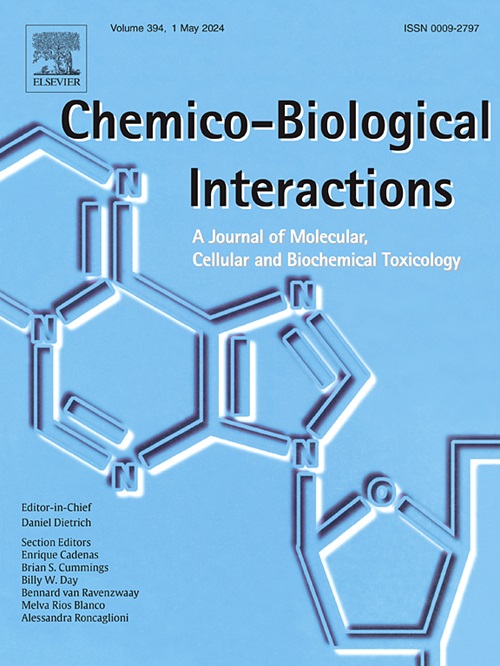Fluconazole induces cardiovascular toxicity in zebrafish by promoting oxidative stress, apoptosis, and disruption of key developmental genes
IF 4.7
2区 医学
Q1 BIOCHEMISTRY & MOLECULAR BIOLOGY
引用次数: 0
Abstract
This study systematically evaluated the toxic effects of fluconazole on the cardiovascular development of zebrafish. Zebrafish embryos were treated with different concentrations of fluconazole (200, 400, and 800 μg/ml) to observe its impact on heart development, reactive oxygen species (ROS) generation, apoptosis, and hemoglobin production. The results showed that as the concentration of fluconazole increased, significant changes in zebrafish heart structure were observed, along with a notable reduction in heart rate. Pericardial edema and cardiac morphological abnormalities were particularly prominent in the high-dose group. In addition, fluconazole treatment significantly increased ROS levels and induced apoptosis in cardiac cells. Enzyme-linked immunosorbent assay (ELISA) results showed that fluconazole treatment significantly increased the malondialdehyde (MDA) content and reduced superoxide dismutase (SOD) and catalase (CAT) activity, suggesting that oxidative stress and cell death may play a key role in its cardiotoxicity. Quantitative reverse transcription polymerase chain reaction (qRT-PCR) analysis revealed that fluconazole treatment significantly affected the expression of several key genes related to heart development and function, particularly cardiac myosin light chain 2 (cmlc2), ventricular myosin heavy chain (vmhc), and myosin heavy chain 6 (myh6), whose expression changes were closely associated with alterations in heart morphology and function. Transcriptomic analysis showed that several signaling pathways related to cardiac development, apoptosis, and metabolism were affected. In summary, this study reveals the multifaceted cardiotoxic mechanisms of fluconazole in zebrafish and provides new insights into drug safety assessment.
氟康唑通过促进氧化应激、细胞凋亡和破坏关键发育基因诱导斑马鱼心血管毒性。
本研究系统评价了氟康唑对斑马鱼心血管发育的毒性作用。采用不同浓度氟康唑(200,400和800 μg/ml)处理斑马鱼胚胎,观察其对心脏发育、活性氧(ROS)生成、细胞凋亡和血红蛋白生成的影响。结果表明,随着氟康唑浓度的增加,斑马鱼心脏结构发生明显变化,心率明显降低。高剂量组心包水肿及心脏形态异常尤为突出。此外,氟康唑处理可显著提高心肌细胞ROS水平并诱导细胞凋亡。酶联免疫吸附试验(ELISA)结果显示,氟康唑处理显著增加丙二醛(MDA)含量,降低超氧化物歧化酶(SOD)和过氧化氢酶(CAT)活性,提示氧化应激和细胞死亡可能在其心脏毒性中起关键作用。定量反转录聚合酶链反应(qRT-PCR)分析显示,氟康唑治疗显著影响了几个与心脏发育和功能相关的关键基因的表达,尤其是心肌肌球蛋白轻链2 (cmlc2)、心室肌球蛋白重链(vmhc)和肌球蛋白重链6 (myh6),其表达变化与心脏形态和功能的改变密切相关。转录组学分析显示,与心脏发育、细胞凋亡和代谢相关的几个信号通路受到影响。综上所述,本研究揭示了氟康唑对斑马鱼的多方面心脏毒性机制,为药物安全性评价提供了新的见解。
本文章由计算机程序翻译,如有差异,请以英文原文为准。
求助全文
约1分钟内获得全文
求助全文
来源期刊
CiteScore
7.70
自引率
3.90%
发文量
410
审稿时长
36 days
期刊介绍:
Chemico-Biological Interactions publishes research reports and review articles that examine the molecular, cellular, and/or biochemical basis of toxicologically relevant outcomes. Special emphasis is placed on toxicological mechanisms associated with interactions between chemicals and biological systems. Outcomes may include all traditional endpoints caused by synthetic or naturally occurring chemicals, both in vivo and in vitro. Endpoints of interest include, but are not limited to carcinogenesis, mutagenesis, respiratory toxicology, neurotoxicology, reproductive and developmental toxicology, and immunotoxicology.

 求助内容:
求助内容: 应助结果提醒方式:
应助结果提醒方式:


